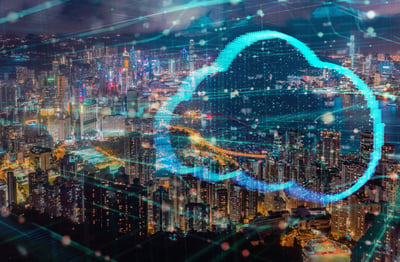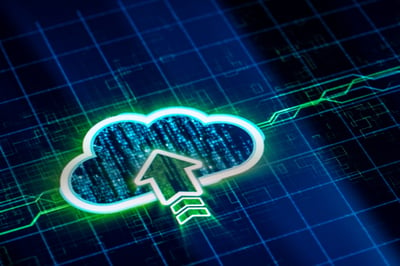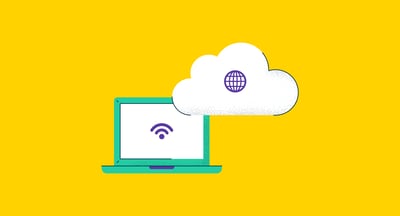

Data is the driver for the internet of things (IoT). The collection, sending and processing of massive quantities of data allows companies to behave more intelligently, act quickly and make better-informed decisions.
However, sending all of that data to traditional cloud networks can lead to latency (that is, the delay before a transfer of data). Edge computing is evolving around the developing need to move much of the processing nearer to IoT sensors themselves to decrease that latency and improve efficiency. According to a study from IDC, 45 percent of all data created by IoT devices will be stored, processed, analyzed and acted upon close to or at the edge of a network by 2020.
Edge computing is a mesh network of data centers which process and store data locally prior to being sent to a centralized storage center or cloud. It optimizes cloud computing systems to avoid disruptions or slowing in the sending and receiving of data. Rather than data being sent back to a cloud or data center, computing is instead conducted on the “edge,” or the periphery, of a network.
With edge computing, each device — which could be anything from a laptop, to an IoT sensor, to an internet-enabled piece of machinery — processes some of the data at the edge, rather than sending it back into the cloud first. By bringing computing power as close as possible to the device sourcing and using the data, network latency can be lowered and sensors can more efficiently share and receive the critical operating data that drives business operations.
This type of computing can be used in many applications, but, in relation to IoT, it enables IoT devices to process data closer to where it is created, rather than sending it to a central data center or cloud right off the bat. By storing some data locally, it speeds up the process of gathering and sharing the large amounts of data that can be associated with an IoT-connected device.
IoT devices often exist in areas where connectivity is unreliable. Edge computing decreases the amount of time it takes to store and process data from IoT devices because the data can be processed before traveling all the way to the cloud or data center. Edge computing is especially impactful for IoT devices and applications that rely on machine learning, and, by extension, large amounts of data, such as facial recognition, intelligent navigation or spatial awareness.
Cloud computing emerged on a widespread scale right around the turn of the new millenium, though the underlying concept of sharing resources via a globally accessible network dates way back to the 1960s, before computers and the internet were even publicly available. Microsoft, AWS and Google were some of the frontrunners in the cloud race, and they are when it comes to edge computing as well. The introduction of cloud computing enabled increased storage and flexibility, all at much lower costs, and now edge computing is bringing networks to areas far from data centers without losing speed or reliability.
You may see articles which claim edge computing is the “cloud killer,” but really, edge computing is just an evolution of the cloud model and the two are complementary to one another. The term “fog computing” has also been used to describe low-hanging clouds that operate closer to the edge. When used in conjunction, cloud and edge computing architectures can work together to store and process data more effectively.
Depending on the problem or necessity of a business related to the data it is gathering, edge computing may be more beneficial in some instances, whereas cloud computing may be better in others. For example, reaction time can be critical in IoT, and sending data to and from the cloud could cause delays (although they may last only milliseconds) which could have negative impacts on the efficiency of IoT devices. Edge computing can help to eliminate or lessen those delays. However, the cloud is still often effectively used as the datacenter for companies using edge computing. It is simply a secondary hub where data is stored after it is processed on the edge, or where non-time-sensitive processing takes place.
In 2018, we will continue to see the trend of cloud and edge computing being used in tandem, advancing the reach and scope of what cloud networks can provide. Companies like AWS, Google and Microsoft have recognized the future of computing on the edge. They are all expanding their data centers around the world so that they can be more decentralized and be closer to devices, regardless of location.
Data is a huge driver of digital transformation, especially with it comes to the implementation of IoT and artificial intelligence (AI). Machine learning algorithms, which rely on large quantities of recent, relevant data can access that data without experiencing latency with edge computing. Faster access to data means that companies can make continuous informed decisions; with IoT sensors, adjustments to workflows and processes can be made on the fly as well. Data that helps automate tasks can be processed and accessed as close as possible to the source. Edge computing provides a stability and reliability that enables businesses to make and automate data-driven decisions. Decreased latency can help any situation in which immediate data analysis is required — such as stopping a machine before it overheats — leading to faster response times overall.
Additionally, edge computing has the ability to drive down computing costs for organizations and can be a cost-effective way to ensure data recency, accuracy, speed and quality. By only sending data short distances and completing much of the computing in a decentralized way, companies can process data much more efficiently. Raw data is managed at the edge of a network and, in turn, computing power and bandwidth requirements are lower, leading to lowered expenses. When managing massive amounts of data produced by sensors in an industrial setting, the ability to process, analyze and sort data prior to sending it can lead to big savings in network and computing resources.
Companies’ cybersecurity efforts can be positively impacted by edge computing, which keeps sensitive data close to the source prior to sending it. This can bring cloud accessibility to some industries with strict security and compliance regulations by allowing sensitive information to be analyzed and anonymized near the source rather than sending potentially revealing information to the cloud. Personal or sensitive information can be sorted out at the source near the device and processed locally there, while any non-sensitive information can be sent to the cloud for processing.
Edge computing has not yet come into the mainstream for businesses, but there are a number of use cases where it’s already making an impact. Below I’ve provided background on how three companies, Dropbox, Nest and GE, are integrating edge into their products to provide improved experiences for their customers. I’ve also included some broader use cases for how companies can begin to adopt and digitally transform their business with edge computing.
Dropbox, a leading file storage and sharing software, has developed its own edge network to deliver better connectivity and faster file access for its customers. The shift to edge took place out of necessity to provide consistent and reliable service to all of its customers, 75 percent of which are located outside of the U.S.
Since 2014, the company has expanded its network from two data centers in the U.S. to having presence on three continents, with representation in 19 cities across the globe. According to Dropbox, as a result of its shift to edge computing, “Some users have seen and have increased sync speeds by as much as 300 percent, and performance has improved across the board.”
The company attests that edge computing has increased median download and upload speeds throughout Asia and Europe. Customers have also shown latency improvements of 5x.
Nest, a producer of IoT home automation devices, has begun to work edge computing directly into the thermostats, cameras and security systems it creates. Its security systems are beginning to bridge the gap between consumer and business, empowering building managers or security companies to increase security in a more intelligent way. On-device processing creates efficiencies in making intelligent and automated security decisions, especially those systems powered by AI.
The Nest Cam IQ indoor security camera, for example, uses image and video recognition to monitor for motion or to verify family members’ faces, allowing for smarter security breach detection and fewer false alarms. The computer vision functions are all processed directly within the camera in the consumer’s home, rather than using large amounts of bandwidth to send the raw video data streams over the network to a central processing center. Processing the data within the device itself enables the security system to make immediate analyses without delay, ensuring increased safety for families. Edge computing with these devices also leads to increased data security, in addition to home security, as data is processed and encrypted before being sent to the cloud.
In late 2017, GE announced that it would expand its suite of edge-to-cloud technologies offered in its portfolio, extending the applications to Predix, the company’s IoT platform. GE’s new offerings allow customers to support large numbers of edge devices — up to 200,000 connected devices from a single console. Additionally, they enable faster and more efficient processing at a low latency, making data and analytics more powerful. Some of these advancements are only being introduced in Q1 2018, so the increased availability of edge solutions will offer companies new ways to drive insights-led actions in an automated, decentralized way.
“Industrials that unlock data to master asset productivity will be positioned to lead,” Bill Ruh, chief digital officer of GE and CEO of GE Digital, said in its announcement. “To power digital transformation, industrial organizations must understand every stage of the asset lifecycle. The company that designs, builds, operates, maintains and services industrial assets is best equipped to help others with their Industrial IoT journeys. And only GE offers the combination of industrial apps, underpinned by an industrial platform, to ultimately drive customer outcomes.”
Here are a few additional industry-specific examples of how edge computing can transform a business:
For manufacturers, machinery uptime and functionality is extremely important. Malfunctions can cause safety hazards, waste employee time and cause delays in production that can impact customers. As edge computing allows IoT data to be processed and acted upon (often autonomously) more quickly than cloud computing, failing machinery could be identified and turned off more immediately, potentially saving the entire manufacturing floor from irreversible disruptions.
Retail may seem like a surprising use case for cutting-edge technology; but in the race to stay relevant as a brick-and-mortar business, edge computing is helping retailers gather and act on data more quickly. Point of sale (POS) data can be gathered and processed immediately on the edge, then transferred to central accounting and forecasting systems in larger batches.
Edge computing, in conjunction with IoT sensors, can be used in warehouses to track and monitor the exact location of objects in real time. The ability to track goods in their exact location can streamline workflows.
Kara is Director, Market Research at G2. She is passionate about understanding people's business problems and educating software buyers to make informed purchasing decisions. Kara builds meaningful relationships with vendors and providers to ensure end users understand the solutions available to them. She has spent the last five plus years building G2's market research team and is dedicated to developing industry-leading taxonomies and resources.
Cloud computing has become a fundamental requirement for most organizations.
 by Salman Saleem
by Salman Saleem
The ‘cloud’ is one of those fashionable words that has dominated tech discourse as of late,...
 by Piper Thomson
by Piper Thomson
Cloud platforms are a necessity for any business trying to make a mark in the digital world.
 by Dibyani Das
by Dibyani Das
Cloud computing has become a fundamental requirement for most organizations.
 by Salman Saleem
by Salman Saleem
The ‘cloud’ is one of those fashionable words that has dominated tech discourse as of late,...
 by Piper Thomson
by Piper Thomson
Never miss a post.
Subscribe to keep your fingers on the tech pulse.



